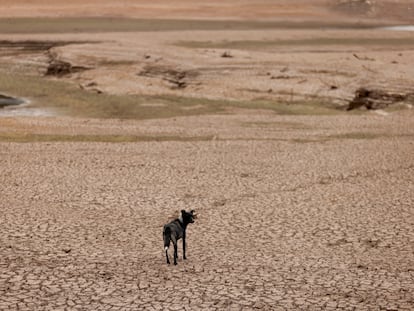High temperatures and heat dome in California and southwestern US: What you need to know
Authorities have issued heat warnings, which will be in effect from Tuesday through Thursday of this week


Intense heat has arrived again in California and other neighboring states. A heat dome is causing a spike in temperatures across the western United States, prompting the National Weather Service to issue major severe heat warnings for the 17 million people living in California, Nevada, Utah and Arizona. Temperature records are expected in cities such as Phoenix, Las Vegas, Reno, Fresno, among others.
On the other hand, the combination of high temperatures, low humidity levels and light winds greatly increases the risk of wildfires. In fact, the Corral Fire has now burned thousands of acres in California’s San Joaquin County, where similar fires burned more than 30,000 hectares last year.
This heat wave — which is expected to push temperatures in some places up to 110 degrees F (43.3 °C) — is linked to the one experienced in Mexico in recent weeks. In that country, temperatures have caused power problems, drought and dozens of deaths. The wave is moving northward, so it will be affecting the aforementioned areas.
What is a heat wave and a heat dome?
A heat wave is a prolonged period of excessively hot weather, which is usually accompanied by a high level of humidity and can have strong impacts on health (causing cardiovascular problems), as well as damage to infrastructure (causing power outages) and ecosystems (increasing the risk of forest fires). It usually lasts for several days to several weeks.
On the other hand, a heat dome is a weather phenomenon characterized by an area of high pressure in the atmosphere that “traps” hot air, which becomes even hotter due to exposure to the sun. This can lead to more intense and prolonged heat waves.
Which areas will be most affected?
High temperatures will envelop the entire western United States, particularly parts of California, Nevada, Utah, Arizona and parts of Texas. Currently, these regions are experiencing temperatures in the 100s Fahrenheit (around 40 degrees C), which is a considerable increase over average for this time of year. Los Angeles will see 5 to 10 degrees warmer than normal.
How long will it last?
The duration of the heat wave and heat dome could last several days, possibly extending into the weekend. According to reports, the heat will begin on Tuesday, June 4 in California, move southeastward on Wednesday, and then reach the Pacific Northwest by the end of the week.
Sacramento is expected to reach temperatures over 100 degrees F (37.7 °C) on Tuesday for the first time this year. Normally, this threshold is reached in early June, but last year it occurred at the end of the month. The Central Valley will also experience triple-digit temperatures Wednesday through the weekend, and Southern California’s desert regions will also be red-hot. Death Valley, known as the hottest place on Earth, is forecast to reach at least 120 degrees F (48.8 °C) on Thursday, earlier than usual. In the Southwest, including parts of Arizona and Nevada, temperatures will approach 110 degrees F (43.3 °C) on Wednesday. Phoenix and Las Vegas are also expected to reach 110 degrees F (43.3 °C) on Thursday.
Precautions
The National Weather Service has made recommendations for Americans to stay safe during this heat wave. They advise staying hydrated with plenty of water, staying indoors with air conditioning, avoiding going out during the hottest times of the day, and watching for symptoms of heat-related illnesses such as heat stroke or fatigue (such as headaches, dizziness, nausea, vomiting, dry skin, thirst, swollen tongue, fever, among others) and seeking medical help immediately.
Likewise, it is essential to take care of vulnerable people such as children, the elderly and people with chronic diseases or those that may worsen due to the heat. It is also recommended to take precautions to avoid forest fires, such as avoiding starting fires outdoors.
Sign up for our weekly newsletter to get more English-language news coverage from EL PAÍS USA Edition
Tu suscripción se está usando en otro dispositivo
¿Quieres añadir otro usuario a tu suscripción?
Si continúas leyendo en este dispositivo, no se podrá leer en el otro.
FlechaTu suscripción se está usando en otro dispositivo y solo puedes acceder a EL PAÍS desde un dispositivo a la vez.
Si quieres compartir tu cuenta, cambia tu suscripción a la modalidad Premium, así podrás añadir otro usuario. Cada uno accederá con su propia cuenta de email, lo que os permitirá personalizar vuestra experiencia en EL PAÍS.
¿Tienes una suscripción de empresa? Accede aquí para contratar más cuentas.
En el caso de no saber quién está usando tu cuenta, te recomendamos cambiar tu contraseña aquí.
Si decides continuar compartiendo tu cuenta, este mensaje se mostrará en tu dispositivo y en el de la otra persona que está usando tu cuenta de forma indefinida, afectando a tu experiencia de lectura. Puedes consultar aquí los términos y condiciones de la suscripción digital.
More information
Archived In
Últimas noticias
There is as much life left to discover on planet Earth as that which is already known
Dozens presumed dead, around 100 injured in fire at Swiss Alps bar during New Year’s celebration
Is porn for women different from conventional porn? We spoke to those who make it
Cartagena de Indias is sinking: What can the city do to mitigate it?
Most viewed
- Sinaloa Cartel war is taking its toll on Los Chapitos
- Reinhard Genzel, Nobel laureate in physics: ‘One-minute videos will never give you the truth’
- David King, chemist: ‘There are scientists studying how to cool the planet; nobody should stop these experiments from happening’
- Oona Chaplin: ‘I told James Cameron that I was living in a treehouse and starting a permaculture project with a friend’
- The Interoceanic Train, the Mexican alternative to the Panama Canal










































